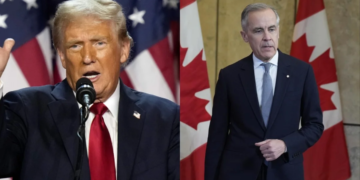President Trump announced something big called “Liberation Day.” He said the U.S. has to be fair in trade, so he’s putting tariffs on almost everything coming into the country. He created a sweeping new tariff regime aimed at countering what his administration views as the unfair trade practices of other nations. This creates the possibility of radical changes in global trade policies affecting vital areas in many countries. So, let’s look at the big trade changes that happened after Trump’s tariffs declaration and how it will affect the economy.
Trump’s Tariffs Plan

Donald Trump loves tariffs! He calls them “the greatest thing ever invented.” His new plan will apply tariffs on almost everything the U.S. imports:
- Baseline Tariff: A 10% tariff will be placed on all goods imported into the United States, effective on April 5, 2025.
- Reciprocal Tariffs: Higher tariffs shall be imposed on countries recognized to be imposing very high barriers on imports into the United States.
- European Union: 20%
- China: 34% (this increases to 54% when combined with a calculation of previous tariffs).
- India: 26%
- Vietnam: 46%
- Japan: 24%
- South Korea: 25%
- Taiwan: 32%
- Thailand: 36%.
- Higher Tariffs for Some Countries: Trump wants even bigger tariffs for countries like China (60%) and Mexico (up to 100%). He says that doing this trade will be fairer and will protect American jobs.
- Exemptions and Special Cases:
- Canada and Mexico: Excluded from reciprocal tariffs by virtue of existing fentanyl-related tariffs and compliance with USMCA.
- Russia: This was excluded from the list despite being a trading surplus entity with the U.S.
- Deficit Countries: Countries like Britain, Brazil, and Singapore would be paying only the baseline 10% tariff.
- Implementation and Authority: The higher reciprocal tariffs shall be effective as of April 9, 2025. Trump declared a national emergency on account of the huge U.S. trade deficit under the aegis of the International Emergency Economic Powers Act(IEEPA).
What is the Reason Behind this Decision?
- Protect American Jobs: By making imported goods more expensive, Americans will purchase more products made domestically instead, which would help factories and workers.
- Raise Government Revenues: The extra payment from tariffs could be used for purposes such as taxpayer features and childcare.
- Punish Unfair Trade: Trump says extra tariffs should be given to countries believed to be taking unfair advantages.
How Will US Tariffs Affect the Economy?
We have the following to say on the expected consequences of these tariffs:
- Higher Prices: Companies usually pass the tariffs to the consumers; this means that toys, clothes, food, and cars could be priced higher.
- Experts estimate that tariff costs will leave middle-class households with $1,700 each year.
- Jobs: Some factories might grow because fewer imports are sold; industries that rely on input imports could also be hurt.
- Retaliation: Other countries might retaliate with tariffs on American goods. For example,
- China could impose levies on soybeans or pork.
- The European Union could hit bourbon or motorcycles.
Mixed Results of Trump’s Tariffs
Tariffs look good for American workers at face value, although in practice they are not apt to go on like that:
- Manufacturing Jobs: While some jobs in-factory jobs will likely expand, others will decrease since factories will similarly want to buy cheaper medium imported inputs.
- Farmers: Farmers selling their soybean crops to other countries may lose out when affected by retaliatory tariffs from those countries themselves.
- Economy: Studies show in retrospect that tariffs don’t hold much in boosting jobs but instead hit the economy hard by pushing prices back.
Supporters argue that tariffs are justified to protect American interests and make trade fair. On the other hand, economists argue that consumers will be the ones to actually pay for increased food, gas, and car prices. They also worry about strained relationships with trading partners.
While Trump’s Tariff debate fires up the world. Supporters such as Japan’s Shigeru Ishiba tiptoe in their responses, whereas critics like U.S. Democrats Chuck Schumer and Nancy Pelosi blast it as irresponsible. Europe and China rebuff strongly and talk about economic bullying. The drama unfolds with allies and foes clashing over Trump’s bold trade play.
Trump’s tariff plan presents a major change in the ways America carries on trade with the rest of the world. It may protect some workers and businesses, but it would put the cost of living for many families up and create some difficulties with other countries. Besides helping or hindering, one thing that is certain is that the success of this plan will lead to enormous changes in international trade!















Discussion about this post